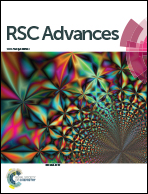Selective detection of glufosinate using CuInS2 quantum dots as a fluorescence probe
Abstract
We designed a novel method for rapid detection of glufosinate, based on quantum dots (QDs) as a fluorescence probe. To date, no studies have been published on the detection of glufosinate using QDs. The innovation of this fluorescence system, which was constructed using CuInS2 QDs and Cu(IDA)·2H2O, is based on the use of intermolecular hydrogen bonds between Cu(IDA)·2H2O and carboxyl group (–COOH) to detect glufosinate. In the fluorescence “turn-on” step, the presence of glufosinate induces the release of Cu(IDA)·2H2O from the surface of the QDs, resulting in fluorescence intensity recovery. This method was performed in relatively clean aqueous solutions. Under optimal conditions, the calibration curve of the method showed good linearity for glufosinate, with a correlation coefficient (R2) of 0.99597. The method was employed to detect glufosinate on fresh tea-leaves, with satisfactory results.



 Please wait while we load your content...
Please wait while we load your content...